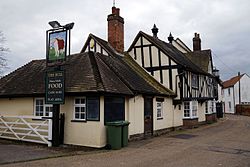Blackmore
| Blackmore | |
| Essex | |
|---|---|
 'The Bull' public house | |
| Location | |
| Grid reference: | TL603016 |
| Location: | 51°41’22"N, 0°19’36"E |
| Data | |
| Post town: | Ingatestone |
| Postcode: | CM4 |
| Dialling code: | 01277 |
| Local Government | |
| Council: | Brentwood |
| Parliamentary constituency: |
Brentwood & Ongar |
Blackmore is a village and ancient parish in Essex. It is located approximately three miles east of Chipping Ongar and four miles north of Brentwood. The village forms part of the civil parish of Blackmore, Hook End and Wyatts Green.
History
The village was recorded in the Domesday Book as 'Phingaria' which was a Latinised form of its original Anglo-Saxon name, Fingreth, meaning 'the stream of the people of Fin'. It is thought that the name Blackmore was introduced in the Middle Ages as a reference to 'Black Marsh' or 'Black Swamp'.[1]
The origins of the Priory Church of St Laurence date back to 1114 and marks the site of a former Augustinian Priory, dissolved during the reign of Henry VIII in 1525. The church is the original building (but without the chancel, which was destroyed at the time of dissolution) and is now the parish church. It has one of the last remaining all-wooden steeples in England which was added around 1400.[2][3] The site still shows signs of the original moat.[4] The village itself is believed to have migrated to a location closer to the chapel of the Priory from around Fingrith Hall during the mediæval period.
Jericho Priory, on the site adjacent to the church and still within the moated area, was built in the 18th century on the site of an earlier 16th-century building which was believed to be the country retreat of Henry VIII and where, in 1520, his 'natural son', Henry Fitzroy, Duke of Richmond, was born.[4]
Other old buildings in the village include the 15th- 16th-century Bull Inn, a traditional Essex timber-framed house, and Fingreth Hall, in the north of the parish, where Sir Walter Mildmay, Chancellor of the Exchequer during the Elizabethan era lived.[4]
Society and leisure
The village is surrounded by countryside and has been named Essex best kept village of the year, for 1982, 1984, 1997, 1998, 1999, 2001, and 2003, and Essex Village of the Year 1997. The village green has a small pond at its eastern end. To the east of the village itself is a cottage which was built in 1345.
There is a village shop, primary school, two village halls, a sports and social club, football and cricket pitches, and a sports arena used for football, netball and hockey. Blackmore Tennis Club is also situated next to the arena. The village has three pubs: The Prince Albert, The Bull, and The Leather Bottle.[5] Societies and clubs include those for the Women's Institute, Scouts, amateur dramatics, sports and fitness, and croquet. Village football teams are Spartak Blackmore F.C., and Infield F.C. Infield F.C., also known as 'The Wasps', are an adult side who play at the Sports & Social Club.
In addition to the Anglican parish church, there is a Baptist church in the village.[6]
Transport
The village is close to the Chelmsford Road, part of the A414, to the A12 and the M11 and M25 motorways; it has rail links from Brentwood—four miles away—to London. Buses connect the village to Brentwood, Ongar and Chelmsford. A service operates from Blackmore to Ongar, Brentwood and Warley.
References
- ↑ Brentwood Official Guide - 2001
- ↑ "Blackmore Church Introduction". http://www.blackmorehistory.co.uk/blackmorechurchintro.html. Retrieved 1 April 2016.
- ↑ "Blackmore Village History". Archived from the original on 27 March 2016. https://web.archive.org/web/20160327164708/http://www.blackmorevillage.com/p/history.html. Retrieved 1 April 2016.
- ↑ 4.0 4.1 4.2 Brentwood Guide
- ↑ "Blackmore village: Social". http://www.blackmorevillage.com/p/social.html. Retrieved 1 April 2016.
- ↑ "Blackmore Churches". http://www.blackmorevillage.com/p/churches.html. Retrieved 1 April 2016.
Outside links
| ("Wikimedia Commons" has material about Blackmore) |